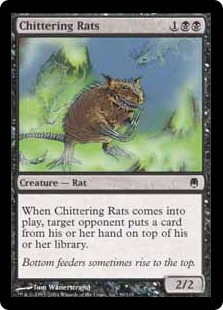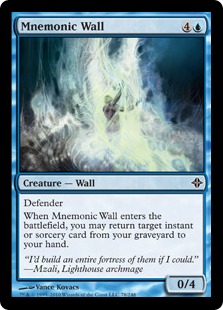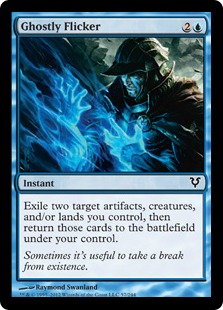Like many articles on Magic, this one starts out with something that has pretty much nothing to do with the topic:
Long before I had ever started tapping things to attack and get mana before I was willing to wait a reasonable amount of time to play ridiculous effects, I was heavily involved in Yu-Gi-Oh. If there are any others like me out there who played Yu-Gi-Oh back in its heyday, he or she will no doubt remember this notorious little bird:
For those who are unfamiliar with this nightmare (which is probably many of you), every turn you were allowed to play one creature, so you played this and attacked your opponent. If he had no way of dealing with it, it hit him directly and would cause him to skip his next draw. Then, on your next turn, you played Yata-Garasu again and surprisingly, your opponent would have no answers, so you would attack him again, forcing him to skip his draw. Do you see a pattern here? If your opponent has no answers to Yata the first time you play him, there is virtually no chance he’ll have any the second, third, fourth, or twentieth time you play the card. This provided the incentive to build a control-based deck that could control the board to the point where Yata could lock down the game (which will forever be known as the infamous “Yata Lock”) and peck your opponent down 200 Life Points at a time (which is virtually nothing, considering the fact that both players start with 8000).
Yata-Garasu has long since been placed on the Yu-Gi-Oh Banned List, which it also played a big part in creating in the first place; however, it has always left me with a strange affinity for locking my opponent out of the game by shutting down the draw step. Naturally, then, you could imagine why I was drawn to the following combo which came to Pauper from Avacyn Restored:
The combo is fairly simple. With Mnemonic Wall and Chittering Rats on the field, you cast Ghostly Flicker, targeting both; they both blink and trigger, so Rats puts a card from your opponent’s hand on top of his library and Mnemonic Wall gets back Ghostly Flicker, so you can repeat this process again and again.
One of the appealing things about this combo is that it is not exclusively a “win-more” combo. Sure, if your opponent has no cards in hand, you are probably favored in that game already, so keeping your opponent from drawing will seem like you are just adding a little extra to a game you have already won. However, this combo is also relevant when the game is far from decided, since casting Flicker still essentially reads, “Your opponent skips his or her next draw,” which is pretty relevant. What this means is that when the board is set up perfectly, where your opponent has no outs to Flicker and has no cards in hand, the combo locks him out of the game entirely and you win; when things are not optimal, flickering Rats and whatnot still affects the state of the game in a pretty relevant way. However, it is still important to note that while the combo is efficient when not in the optimal situation of the opponent having no cards left, you cannot possibly expect it to single-handedly turn the game around and win from nowhere. Thus, making sure the deck, into which the combo is incorporated, has other things to do is essential.
As with all new combos and deck ideas, it’s absolutely essential, in my opinion at least, to eliminate bias and to evaluate the deck as analytically as possible in order to make sure that it is not simply a gimmick, and furthermore, in order to understand the possible options for building it up into 75 playable cards.
In the case of this interaction, my initial concern was that it seemed to be doing nothing terribly unfair for a three-card combo. If you Ghostly Flicker your Rats and your Wall, you have a net gain of one card (the card that goes back on top of the library). This also does not consider all of the setup that goes into casting a 5-CMC Wall and a 1BB creature, but let’s ignore this for the moment. The question which immediately came to me was, “If you are going way out of the way for Ghostly Flicker for a gain of 1 card, how is this any better than just doing something far simpler, such as casting a Divination or Mind Rot which yields the same net advantage?”
Well, it’s an instant…
But more importantly, I think an answer can be found in the quality of this particular +1 and the value of getting Ghostly Flicker back instead of another card on top of your deck, as is the case with something like Divination.
This immediately leads into the next question (even though I still didn’t really answer the first one yet). I think it is pretty safe to say from my own experiences that a “Target opponent puts a card from his or her hand on top of the library” effect is much stronger in general than a “Target opponent discards a card,” but it is unclear how much better it actually is and, more interestingly, why it is better. In both cases the overall net loss is one card from the hand, but this is a deceptive answer in my opinion. In the case of a discard, such as Ravenous Rats, the resource affected is the hand, and your opponent has the choice of which card is lost. In practice, this typically results in a player pitching the most irrelevant card and carrying on. However, in the case of Chittering Rats, the resource which is disrupted is not the immediate hand, but the draw step. This removes the element of choice from this effect, which is obviously still a part of Ravenous Rats, as well as the other things such as Mind Rot and the many other similar cards, so what you are actually doing is denying your opponent a random card, which becomes far better over the course of a turn or two. I also think this is an accurate evaluation because, while Chittering Rats has a better effect than Lilianas Specter, it would seem pretty on par with a 1BB creature that caused a random discard when entering the battlefield.
Secondly, and perhaps more importantly, is the fact that the Ghostly Flicker replaces itself, which, although appearing as no overall net card gain, is quite relevant in that it provides inevitability, which is far from the case of the other ‘+1 cards,’ in the form of eventually locking the opponent out of the game. In some sense, the combo is to hand disruption what Capsize is to bounce, where the “unfair” aspect of the card is not simply in what the card does, but in the fact that the effect is.
Additionally, Ghostly Flicker can sometimes, in optimal situations, act as a 3-for-1 by also countering an opponent’s spell by flickering its target. As such, it does gain potential additional value from these situations, but it is difficult to consider when evaluating the card in concreto because it depends heavily on whether or not your opponent is actually playing cards that can be countered in this way and also on the assumption that your opponent is not playing around Ghostly Flicker. Furthermore, these occurrences will be highly situational, and thus shouldn’t be weighed too heavily when we’re primarily considering how the card typically performs.
So this explains why the whole project of a ‘Ghostly Flicker combo deck’ has some merit, particularly from the repeatability and inevitability of Flicker, which is an important consideration when adding it into decks, since it will obviously lend itself much more readily to slow, controlling builds that can capitalize on this advantage. Without the time or resources to profit from recycling Flicker, it will typically be acting as a worse version of Mind Rot.
One of the hallmarks of a ‘bad combo deck’ is that it uses awful cards to combo into a lackluster or minimally decent effect. Fortunately, while this combo is difficult to set up, the combo pieces are all excellent cards in themselves. Mnemonic Wall replaces itself (and also returns a Ghostly Flicker from the graveyard). Chittering Rats forces your opponent to lose a card. And Ghostly Flicker is some sort of a +1, assuming you also have a reasonable number of things to target with it. The high individual power level of each combo piece drastically increases the competiveness of the combo, since the individual combo pieces do not require too much justification to make their way into a deck aside from them being good cards.
So having evaluated the combo, we can now look at some of its possible applications:
Ghost Post
Blue Black Post by gogogadgetcoaster
|
| ||||||||
This first approach takes the combo pieces and jams them into what would otherwise be a fairly typical UB Post deck.
It is no shock that Ghostly Flicker would find a home in this deck since it not only typically runs Mnemonic Wall, but also runs a variety of other permanents which act as excellent Flicker targets. Mulldrifter and Prophetic Prism can blink to draw cards (you can even Flicker a Mulldrifter in response to its evoke-sacrifice trigger to keep it around and draw 4 cards for a net UU4); Chittering Rats disrupts the opponent’s draw; Glimmerpost can gain life; and Serrated Arrows resets its number of counters and untaps. Not only does Ghostly Flicker have powerful interactions with these cards, it also has a considerable degree of versatility, existing simultaneously as a life gain/draw/hand disruption/removal spell that can renew whatever resources are needed in a particular matchup.
The versatility of this deck also goes well beyond Ghostly Flicker, as Forbidden Alchemy, Mystical Tutor, and Mnemonic Wall (particularly in conjunction with the milling aspect of Alchemy) allow you to dig through the deck at a fairly rapid pace to find answers to whatever the opponent is doing and also to grab Ghostly Flicker which opens up more options already listed above in addition to threatening the lock.
Overall, I really like how perfectly the combo can be integrated into the UB Post builds. The complexity of the build which results permits it to access a toolbox in many different ways and then use this to attack from a variety of different angles in threatening to win through shutting the opponent out with Capsize or shutting the opponent out with a flickering Rat.
My biggest concern when playing the deck on MTGO was typically the clock, which is something to consider and be actively aware of if you decide to virtually sleeve up this list. Control decks can sometimes be notorious for slow, grinding games where one player wins by attacking for two damage each turn, especially in Pauper, so it’s not a complete shock for this deck to face the same problem. However, when you actually do lock the opponent out of the game, you do have to resolve a considerable number of triggers each turn, which quickly eats away at the clock. This has little to do with the actual construction of the deck beyond promoting the addition of more actual “finishers” to the list beyond its current eight 8 attacking creatures.
Mono-Black… with Blue
The second option is to forego some of the blue control aspects of the deck and incorporate it into a Mono Black deck shell. For example:
Mono-Black and Blue by Michael Radzwilla
|
| ||||||||
For starters, I know that when you add blue to a Mono-Black deck, it is no longer a Mono-Black deck; however, the deck is still designed to do exactly what Mono-Black traditionally does: play value creatures and removal until the opponent runs out of resources. Adding Ghostly Flicker to the mix adds a level of explosiveness which the deck typically does not have as well as provides an additional plan for an end game in the Flicker lock, which gives it greater inevitability than the traditional plan of just sticking a Corrupt for 20.
The reason to normally be skeptical of diluting Mono-Black with an additional color is firstly that Tendrils and Corrupt work better with a higher Swamp count, but more importantly because so many of the cards are so heavily-costed with black mana that adding a second color begins to make it look like you’re begging for inconsistent draws. However, I feel like an exception can be made for Ghostly Flicker for two reasons. First, it offers an effect from which the deck can greatly benefit. Second, Flicker does not need to be cast immediately, and is typically going to be better later in the game than earlier. For this reason, the number of Islands required to make the splash can be kept fairly low, which will have a pretty low impact on the quality of the mana base.
Also, if this article were not specifically about Chittering Rats, Mnemonic Wall, and Ghostly Flicker, I would strongly consider adding Ninja of the Deep Hours in place of the Mnemonic Wall; however, the problem with doing this is that, unlike Wall and Flicker, Ninja of the Deep Hours really requires a ready blue source and it is most effective when used early as opposed to later (unlike Wall and Flicker). This means that adding Ninja, despite its many synergies with all of the creatures in the deck, does put a pretty heavy toll on the mana base, which is a fairly strong argument against its inclusion.
Mnemonic Wall may initially seem a little out of place in this deck, but it does have sufficient decent interactions to make it more than a “bad combo piece.” At worst, it will get back a removal spell; at best, it will get back Corrupt and act as a solid Grim Harvest target.
Conclusion
Overall, I think that Ghostly Flicker opens up several new tricks for already-established decks (some of which have not been mentioned here) and, through its interaction with Chittering Rats and Mnemonic Wall, offers a new way for these decks to pressure an opponent. But, as always is the case with exploring deck ideas, this article is by no means intended to be exhaustive; rather, it is to set a starting point from which more ideas can develop and to provide a ground for those creations to start.
As always, thank you for reading my article. I really appreciate your feedback in the comments below, and am always looking for further suggestions on future content and ways to improve. Thanks!






nup.
Does it work? The effect of the wall flickering back into play triggers while Ghostly Flicker is still on the stack…making it impossible to put Ghostly Flicker back into your hand with the wall…at least i’m pretty sure. Please correct me if i’m wrong!
You’re correct that the ability triggers when Flicker is on the stack, but a trigger is only put on the stack when a player receives priority and that would be right after the Ghostly Flicker resolved and was put into the graveyard.
@ Kainius. It does work, when the walls ability goes onto the stack, flicker has already resolved and is in the graveyard, ready to be brought back to your hand.
I prefer a combo involving 2 izzet boiler works, Mnemonic Wall, Cloud of Faeries, Ghostly Flicker and a grapeshot. Generate infi mana then grapeshot them for the win – 6 card combos are the best!
I just shared this over at MTGSalvation as someone is working on a deck similar to this but, they had came up with some other ideas. Good article. Looking forward to the next one.
Am I the first one to say that the second deck only has 56 cards? Nice work.
just did my first combo with this deck. game ended in concede by opp. Maybe grim harvest could be stuffed in there somewhere, to ensure the combo against heavy removal decks???
but the undying thingy kinnda does that in a way…. hmm. maybe it’s just me, i just love post decks with gharvest